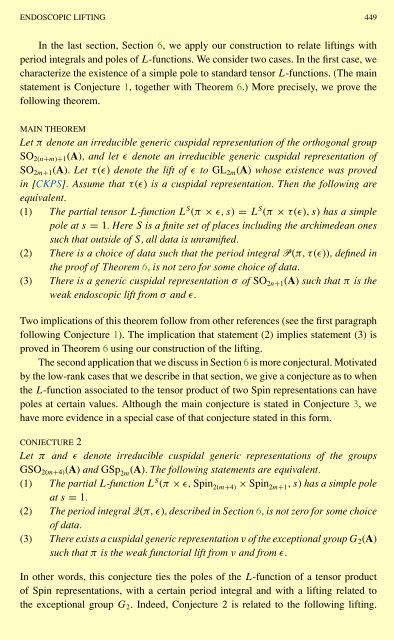A NULLSTELLENSATZ FOR AMOEBAS
A NULLSTELLENSATZ FOR AMOEBAS
A NULLSTELLENSATZ FOR AMOEBAS
Create successful ePaper yourself
Turn your PDF publications into a flip-book with our unique Google optimized e-Paper software.
ENDOSCOPIC LIFTING 449<br />
In the last section, Section 6, we apply our construction to relate liftings with<br />
period integrals and poles of L-functions. We consider two cases. In the first case, we<br />
characterize the existence of a simple pole to standard tensor L-functions. (The main<br />
statement is Conjecture 1, together with Theorem 6.) More precisely, we prove the<br />
following theorem.<br />
MAIN THEOREM<br />
Let π denote an irreducible generic cuspidal representation of the orthogonal group<br />
SO 2(n+m)+1 (A), and let ɛ denote an irreducible generic cuspidal representation of<br />
SO 2m+1 (A). Letτ(ɛ) denote the lift of ɛ to GL 2m (A) whose existence was proved<br />
in [CKPS]. Assume that τ(ɛ) is a cuspidal representation. Then the following are<br />
equivalent.<br />
(1) The partial tensor L-function L S (π × ɛ, s) = L S (π × τ(ɛ),s) has a simple<br />
pole at s = 1. HereS is a finite set of places including the archimedean ones<br />
such that outside of S, all data is unramified.<br />
(2) There is a choice of data such that the period integral P(π, τ(ɛ)), defined in<br />
the proof of Theorem 6, is not zero for some choice of data.<br />
(3) There is a generic cuspidal representation σ of SO 2n+1 (A) such that π is the<br />
weak endoscopic lift from σ and ɛ.<br />
Two implications of this theorem follow from other references (see the first paragraph<br />
following Conjecture 1). The implication that statement (2) implies statement (3) is<br />
proved in Theorem 6 using our construction of the lifting.<br />
The second application that we discuss in Section 6 is more conjectural. Motivated<br />
by the low-rank cases that we describe in that section, we give a conjecture as to when<br />
the L-function associated to the tensor product of two Spin representations can have<br />
poles at certain values. Although the main conjecture is stated in Conjecture 3, we<br />
have more evidence in a special case of that conjecture stated in this form.<br />
CONJECTURE 2<br />
Let π and ɛ denote irreducible cuspidal generic representations of the groups<br />
GSO 2(m+4) (A) and GSp 2m (A). The following statements are equivalent.<br />
(1) The partial L-function L S (π × ɛ, Spin 2(m+4) × Spin 2m+1 ,s) has a simple pole<br />
at s = 1.<br />
(2) The period integral Q(π, ɛ), described in Section 6, is not zero for some choice<br />
of data.<br />
(3) There exists a cuspidal generic representation ν of the exceptional group G 2 (A)<br />
such that π is the weak functorial lift from ν and from ɛ.<br />
In other words, this conjecture ties the poles of the L-function of a tensor product<br />
of Spin representations, with a certain period integral and with a lifting related to<br />
the exceptional group G 2 . Indeed, Conjecture 2 is related to the following lifting.
















